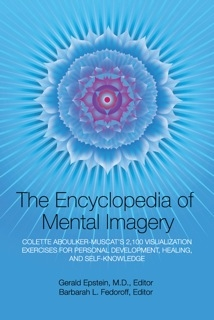The Encyclopedia of Mental Imagery
Colette Aboulker-Muscat's 2100 Visualization Exercises for Personal Development, Healing, and Self-Knowledge
Spare and evocative in nature, the 2,100 short visualizations in The Encyclopedia of Mental Imagery: Colette Aboulker-Muscat’s 2,100 Visualization Exercises for Personal Development, Healing, and Self-Knowledge stretch the boundaries of imagery exercises. They serve as enigmatic doorways and catalysts for change, drawing from mystical wisdom and creative traditions across millennia.
Each section of the book opens with a quote from a poem by the late Colette Aboulker-Muscat. The editors have ably collected and recorded her imagery. (The poems are collected in her book Alone with the One.) Aboulker-Muscat, who grew up in Algeria, studied psychology at the Sorbonne in Paris following a childhood of serious illness and an early awareness of spirit and healing through imagery. Thousands learned her Waking Dream and Group Imagery methods. Some readers of The Encyclopedia of Mental Imagery might wish for more details from this compelling backstory.
With abundant nonlinear access points, this self-help book of exercises invites readers to tap into their inner wisdom. Mental imagery “is the mind speaking to us in pictures,” write coeditors Gerald Epstein and Barbarah L. Fedoroff. “Imagery conveys the wisdom of our minds and longing of our hearts.”
Forty-one themes organize the imagery exercises, including topics like clarity, awareness, self-renewal, regaining health and wholeness, and seeking truth the Christian way. The text reveals the essence of thinkers and sources from Lao Tzu and the Old Testament to Plotinus, Richard Bach, R.D. Laing, and Gabriel Garcia Marquez. Distilled wisdom, not direct quotes, most of the entries are one to four lines in length, with the longest a half page.
In a section of short imagery exercises called “Defeating Death: From Gabriel Garcia Marquez,” an image like, “Imagine you have taken an eternal ticket for a train that never arrives at its destination” resonates as if pulled from One Hundred Years of Solitude.
The helpful opening sections provide context and guidance for creating a personal imagery practice. Contrary to common practices, the coeditors argue that, “the shorter the time you stay in an image, the more powerful the result will be. Most imagery exercises are short and take only five to fifteen seconds.” The editors address those for whom imaging doesn’t come easily, suggesting that they begin by using nonvisual senses, or “rely on senses you use … most easily.”
Shorthand instructions provide guidance for conscious breathing. For example, “BO3X” translates as “breathe out three times.” Icons serve as visual keys guiding readers to short pauses between imagery exercises, such as “breathe out, open your eyes, rest a moment, then close your eyes.”
A new generation seeking health and wholeness will be fortunate to access this legacy of a spiritual teacher, mystic, and poet who deserves to be more widely known.
Reviewed by
Bobbye Middendorf
Disclosure: This article is not an endorsement, but a review. The publisher of this book provided free copies of the book and paid a small fee to have their book reviewed by a professional reviewer. Foreword Reviews and Clarion Reviews make no guarantee that the publisher will receive a positive review. Foreword Magazine, Inc. is disclosing this in accordance with the Federal Trade Commission’s 16 CFR, Part 255.

